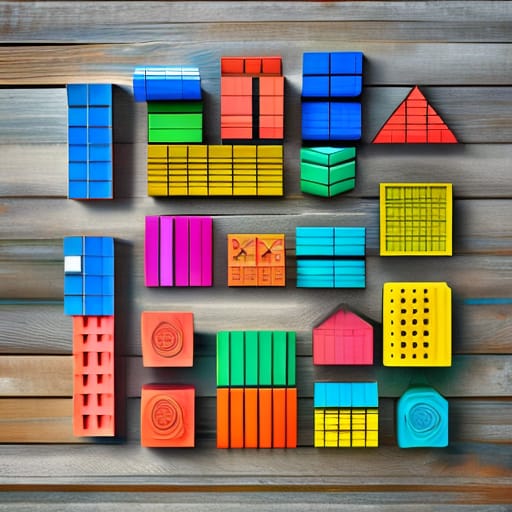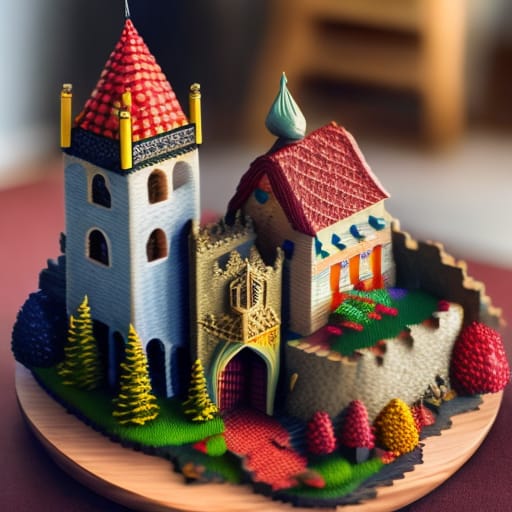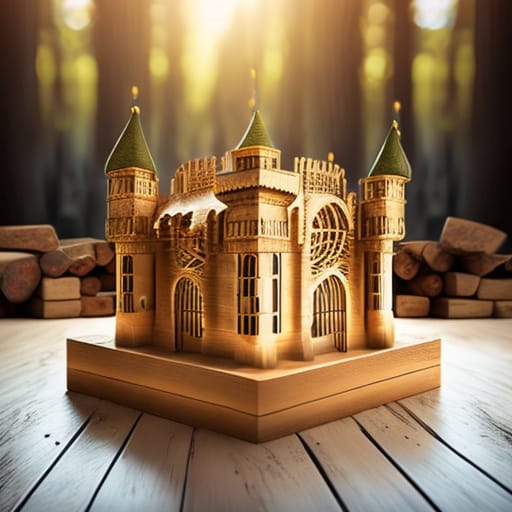As a child, did you ever dream of living in an elaborate castle with turrets, towers, arches and ramparts? Do your kids love pretending to be brave knights and fair maidens? With the Fao Schwarz 75-Piece Wooden Castle Blocks Set, you or your children’s imagination can run wild constructing medieval castles and fortified structures straight out of a storybook.
These high-quality natural wooden blocks come in eye-catching colors and are perfect for open-ended, creative play. Children will be enthralled building bridges, towers, and custom archways then using them for exciting roleplaying games or to test principles of engineering and physics. Parents will also appreciate the set’s ability to foster a range of developmental skills.
What are Wooden Castle Blocks?
Wooden castle blocks are classic children’s toys comprised of various geometric shaped blocks made from smooth sanded wooden pieces. They can be used to construct the walls, towers, gates, and keeps of medieval castles and fortresses.
Castle blocks inspire creative building play and storytelling. They engage key parts of a child’s development including:
- Fine motor skills – Precision required to balance blocks builds dexterity.
- Spatial intelligence – Envisioning structures taps spatial reasoning.
- Problem-solving – Altering designs that don’t work trains critical thinking.
- Collaboration – Building together teaches teamwork and communication.
Wooden blocks offer timeless open-ended play value as they can be built and reconstructed in infinite ways. Children use their own creativity and ideas – there is no right or wrong way to build. Unlike kits or structured building sets, kids control the ultimate design.
Their hands-on, tactile nature provides sensory stimulation andmakes them popular toys for Montessori and Waldorf education programs. Preschool and kindergarten teachers also use wooden blocks frequently in early education curriculums focused on learning through play.
Overview of the Fao Schwarz 75-Piece Castle Block Set
The 75-piece Fao Schwarz set strikes an ideal balance between size and play value. With its vibrant color palette and whimsical castle illustration on the box, it promises hours of building adventures.
What’s Included
The Fao Schwarz castle building kit contains:
- 30 large blocks
- 20 small blocks
- 10 medium blocks
- 10 arches
- 5 ramps
Blocks come in six bright colors – red, blue, green, yellow, orange and pink. The set has enough variety for both freestyle creative building as well as pre-designed structures.
Multiple sizes and shapes of blocks including ramps and arches increase the complexity of structures kids can engineer. The pieces are made from high-quality pine wood sanded extra smooth. They hold together by stacking but come apart easily too – no glue or tools needed.
Benefits of Open-Ended Building Toys
Freeform building toys like wooden blocks offer a host of benefits that make them staples of early education settings. Unlike toys with fixed outcomes, they allow the child to determine play patterns.
Promote Creativity and Imagination
There is no limit to what a child might envision and construct. From medieval castles to futuristic cities, monster trucks to rocket ships, wooden blocks fuel imagination and storytelling.
They provide a blank canvas for make-believe playable art. The presence of ramps and arches in this Fao Schwarz set further extends creative potential into new frontiers.
Develop Spatial and Engineering Skills
Figuring out how to build sturdy structures requires plenty of trial and error. Kids naturally build an understanding of spatial relationships, architecture principles, balance and geometry.
Concepts of symmetry, patterns, proportion and scale are reinforced each time a tower gets too tall and topples over! With adult guidance, preschoolers can even grasp basics of structural engineering.
Teach Persistence and Problem-Solving
Importantly, wooden blocks teach kids persistence in the face of setbacks. Block constructions may fall repeatedly, but children learn to analyze why and try new solutions. This builds critical resilience, coping and the ability to overcome frustrations.
Adults can foster this by asking constructive questions like “What are other ways you might brace or reinforce your tower?” This strengthens creative problem-solving abilities – an invaluable skill for life.
Allow Collaborative Play
Collaborating on building projects reflects how teamwork unfolds in the real world. Kids learn to share ideas, divide tasks, give and receive feedback to work toward a common goal.
They practice communication, listening, compromise and including everyone. These pro-social skills provide a strong foundation for future leadership, relationships and conflict resolution.
Offer Repeated Learning Cycles
Trial and error is not just an essential part of the scientific process but also how children’s brains grow dendritic connections. Mastering a skill requires practice – wooden blocks enable this through repeated building/rebuilding.
Each small accomplishment of a bridge held up or towers reinforced is a neurologic victory that motivates kids to push further. Success sparks dopamine release teaching young brains that effort pays off.
Build Confidence and Resilience
Free choice and control allow kids to build their capabilities at their own pace. Small victories and achievements accumulate to grow children’s self-confidence and resilience.
Having opportunities to experience mistakes in a safe, nurturing environment is pivotal to raising persistence. Children learn to pick themselves up, try new tactics and solve problems.
This fosters a growth mindset helping kids acquire grit to tackle tougher challenges ahead. Perseverance and self-efficacy gained serve long past childhood.

Types of Building Play
Depending on your child’s age, interest and skills, wooden blocks support different types of building play.
Early Exploratory Play
Babies and toddlers enjoy exploring blocks through simple manipulation and arrangement. They graspnig them, turn them, knock them over and line them up. This pre-constructive play builds fine motor control and cognition.
Toddlers start basic stacking and linking block pieces together. Completing simple constructions boosts their confidence and pride.
Creative and Imaginative Building
Preschoolers invent intricate stories around their block structures. One minute it’s a castle, the next a house, school or zoo. Block creations become backdrops for role play adventures acting out tales of royalty, heroism and make-believe.
Adults can engage with kids asking about their structures. Their answers give delightful insights into blooming perspectives. Open questions like “What do you imagine this block could be?” further spark imaginative scenarios.
Structural Engineering and Design
As school-aged children gain experience, they implement more planning when building. Their block constructions begin resembling real-world buildings and objects.
Kids start engineering contraptions to test concepts they learn in science like ramps, leverage, energy transfer and gravity. Adults can introduce terminology and coach basic design strategy.
By late elementary school, kids readily incorporate height-width ratios, cross-bracing, symmetrical facades and other design techniques for sturdier buildings.
While kids start building for fun, the repetitive cycle of imagining, creating, testing and troubleshooting structures trains computational thinking. The spatial visualization, critical analysis and perseverance serve kids well in later math and science disciplines.
Top Builds for Preschoolers
Young kids can make exciting constructions both real and imagined from castle block sets. Beyond medieval castles, here are fun ideas to inspire beginner builders ages 3 to 6:
Rocket Ship
Stack blocks vertically with spaces in between to form a tall tower for the rocket. Use ramps or arches on the top as the nose cone. Build shorter solid stacks on the sides for engines and fins.
Blast off to explore outer space adventures! Add a control panel inside from horizontal blocks. Bring along a toy astronaut or alien figures for the ride.
Garage
Make a small enclosure from blocks to house toy cars and trucks. Include ramps to mimic driveways and openings as doors.
Use leftover blocks to build roads and buildings around it. Zoom vehicles up and down the ramps and park them inside when not in use.
Bridge
Line up blocks end-to-end across a short span on the floor. Practice making patterns using different colors as you extend the bridge.
See if toy cars or trains can ride smoothly from one end to the other without falling off. Try making tunnel shapes or crossing two structures.
Zoo
Construct a variety of enclosures to contain plastic animals or figurines. Vary the height and width of block walls to suit each creature.
Add toys like trees, bushes and even visitors to make habitats more realistic! Place ramps in some pens to resemble tunnels or caves. Display signage naming the animals using paper.
Reconfiguring just a few blocks at a time fuels a child’s sense of accomplishment and prolongs engagement. Fortifying structures incorporates engineering elements while leaving room for imaginative narratives to unfold.
Comparison to Other Castle Block Sets
While many manufacturers offer castle-themed building block sets, the aesthetics and play value vary greatly. I compare the Fao Schwarz option to two top competitors:
Primary Play Castle Blocks Building Set
Primary Play offers a 101-piece wooden castle blocks kit with a medieval theme. The set substitutes some standard blocks with uniquely shaped sculptural pieces like 3D horses and crowns.
Pros
- More total pieces
- Intricate theme-inspired shapes
- Compatible with other sets
Cons
- Higher cost
- Sculpted pieces limit building flexibility
- Smaller standard blocks
As a starter kit, the embellished Primary Play set provides robust roleplay-specific pieces but lacks block variety for free-building.
Melissa & Doug Castles Building Blocks
This 60-piece painted wooden block set features chunky numbered blocks with corresponding picture cards for matching games.
Pros
- Great starter for toddlers
- Number/object correlation
- Thick easy-grip blocks
Cons
- Fewer pieces limits designs
- Focus on early math vs. construction
Melissa and Doug’s set works well for early builders but offers less creative building potential long-term.
Ultimately the Fao Schwarz 75-piece kit strikes an ideal balance between free building flexibility, early STEM skill building and pretend castle play. The value, quality and developmental range make it a superb starter castle building set.
Best Ages for Wooden Castle Blocks
Developers design engaging toys for specific age groups based on safety standards, choking hazards, skill levels and more. Keep this in mind when selecting the best building blocks for your child’s age:
Under 3 Years
For very young toddlers who still mouth toys, avoid small loose blocks. Choose sets with oversized blocks at least 1.5 inches wide like Melissa & Doug’s numbered blocks.
Prioritize safe materials, ease of cleaning and building confidence with simple stacking or pairing. Supervise play closely and limit towers to 6 blocks high only.
Ages 3-4 Years
Preschoolers can handle more complex structures but still require attentive supervision. Sets with 30-50 blocks like the Fao Schwarz kit allow substantial building creativity appropriate for this age.
Kids’ fine motor skills can manipulate smaller blocks while bigger pieces facilitate stability. Building vocabulary expands as kids start telling stories around constructions.
Ages 5-6 Years
Early elementary schoolers possess the dexterity for intricate block structures with multi-step planning. They follow symbol patterns, problem-solve supports and incorporate roleplay themes.
Larger 100+ piece kits with ramps, doors and specialty blocks provide exciting challenges. Kids also start collaborating on building team projects at this age.
Regardless of age, always oversee young children playing with small blocks to prevent accidental choking hazards or improper usage.
Where to Buy Fao Schwarz Castle Blocks
The 75-Piece Fao Schwarz Wooden Castle Block Set is sold exclusively by Entropy Toys both online and in their stores. This specialty toy company focuses on promoting open-ended play and imagination.
Online
The Entropy Toys website offers free shipping on orders over $25 plus regular sales and specials. Stock up on multiple sets for free home delivery.
In-Store
Find a full selection ofEntropy Toy brick-and-mortar locations via their store locator. Stores offer hands-on product demos and activity calendars.
Ask about creating a custom themed gift set with castle blocks and compatible figures or environments like forests and kingdoms. Or pair it with costumes for the ultimate castle role play bundle!
Cost Breakdown
The price per piece and quality of Fao Schwarz’s 75-piece wooden castle block set offer outstanding value. Similar smaller basic block sets sell for over $1 per piece.
Competitor Price Comparison:
| Set | # of Pieces | Price | Cost Per Piece |
|---|---|---|---|
| Fao Schwarz | 75 | $59.99 | $0.80 |
| Primary Play | 101 | $89.99 | $0.89 |
| Melissa & Doug | 60 | $42.95 | $0.72 |
Special sale pricing as low at $49.99 makes this Fao Schwarz set even more attractive for budget-conscious parents.
Consider the developmental return on investment too. Well-designed building toys pay dividends over years in emerging creativity, spatial skills and reasoning capability. Their open-ended flexibility ensures long-lasting play.
On a cost per use basis, this reasonably priced castle kit delivers exponential value over time. The pieces easily integrate with existing block collections enabling more build possibilities.
How Castle Blocks Are Made
Understanding how wooden toys are sourced, manufactured and tested offers peace of mind on critical safety issues.
All Entropy Toys building kits including these Fao Schwarz Castle Blocks follow rigorous environmental and material quality controls.
Raw Materials
Entropy uses solid maple, birch and pine woods responsibly harvested from replenished forests not old-growth trees. Woods are chosen based on safety – they don’t splinter and don’t leach chemicals.
Domestic lumber minimizes carbon footprint for US manufacturing. Wood is also naturally biodegradable and recyclable.
Safe Processing Standards
Air and kiln drying methods eliminate over 90% moisture content preventing warping, cracks or fungus. Water-based dyes add vibrant colors meeting strict US toy safety requirements. The pieces are polished smooth as silk.
Entropy’s US-based factories adhere to guidelines from the Consumer Product Safety Commission (CPSC) for toy construction.
Rigorous Testing
Finished blocks undergo standardized tests assessing:
- Structural integrity
- Flammability
- Toxicity
- Lead and phthalates
Outdoor durability tests expose pieces to extreme weathering – even termites! This ensures enduring enjoyment through every childhood and beyond.
Aggressive stress testing confirms structures won’t collapse dangerously. You can rest easy kids playing even with the tallest block towers made.

Eco-Friendly Production
In addition to sustainably sourced natural woods, Entropy Toys prioritizes environmental stewardship across manufacturing.
Wood Waste Recycling
Excess lumber trim and sawdust gets recycled to heat factory buildings. Or it’s made into other usable goods like mulch and wood pellets.
Water Conservation
State-of-the-art runoff collection and treatment converts wasted water into cleaner runoff than the intake. Almost zero water gets wasted even cleaning machinery.
Renewable Energy
Solar panels and wind turbines generate over 60% of the power needed to run factory equipment. Energy efficient LED lighting skylights and smart meters further reduce usage.
Ethical Sourcing
Suppliers must certify environmental compliance and fair labor practices. Entropy audits partner facilities unannounced biannually. This commitment to sustainability makes me proud to recommend their products.
By supporting Entropy Toys, you’re assured high-quality educational toys crafted the right way. Their castle blocks set empowers wholesome play for budding young minds. Kids gain creativity, persistence and problem-solving to succeed both in childhood and beyond.
Frequently Asked Questions
What age range is best for the Fao Schwarz castle blocks set?
The 75-piece kit works well for kids ages 3 to 8 years old. The small parts pose a choking risk for toddlers under 3 who still mouth toys. Younger kids also lack the fine motor skills needed for intricate stacking. Around age 3, preschoolers can start building basic structures. By ages 5 to 6, most kids possess enough manual dexterity for advanced creations. They also have longer attention spans to sustain complex constructions.
How are wooden castle blocks better than plastic?
Wooden blocks feel more aesthetically pleasing thanks to gorgeous natural grains and rich hues. The natural tactile warmth and smoothness of sanded wood offers superior sensory input over cold plastic. Wood also makes satisfyingly solid clacking noises when piled that foster sensory integration.
Eco-conscious parents appreciate wooden toys made from replenishable maple, birch and pine. They don’t leach potentially toxic BPAs or phthalates like plastic. Clean unfinished wood with non-toxic colors passes stringent US safety tests for toys.
What developmental skills do castle blocks build?
Beyond sparking creativity and imagination, castle blocks support vital developmental areas:
- Fine motor control – Precision balancing pieces develops dexterity.
- Spatial skills – Envisioning future structures utilizes mental rotation and mapping capability.
- Critical thinking – Modifying builds that fail improves kids’ problem-solving abilities and resilience when facing challenges.
Can I add to the Fao Schwarz 75 piece set?
Absolutely! Mixing castle block sets allows even more creative play. Supplementary kits by Entropy like forest animals, medieval knights or royalty boost castle roleplaying possibilities.
For mega-constructions, combine with their standard wooden peg building bricks or jumbo community blocks. Just ensure any new pieces meet Entropy’s safety standards and quality controls for a safe experience.
Do castle blocks help STEM learning?
Building freely with wooden blocks trains foundational cognitive competencies used heavily in science, technology and math disciplines. Spatial relationships, designing structures through trial-and-error and visualizing end results all teach important engineering and computational principles.
The repetitive construct -> test -> refine -> retry loop mirrors the scientific process and tech design thinking. As kids recreate real-world buildings, vehicles or tools with blocks, they reinforce practical physics and architecture concepts. Figuring out how to balance irregular loads strengthens geometric and mathematic reasoning naturally.
